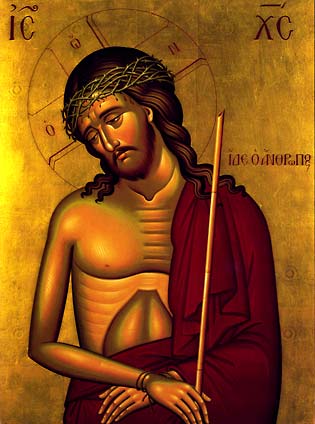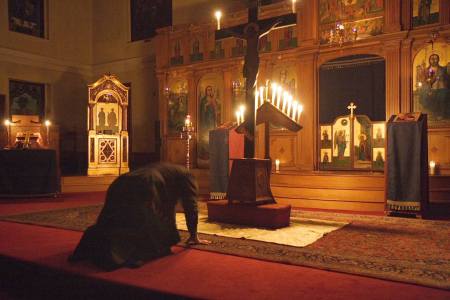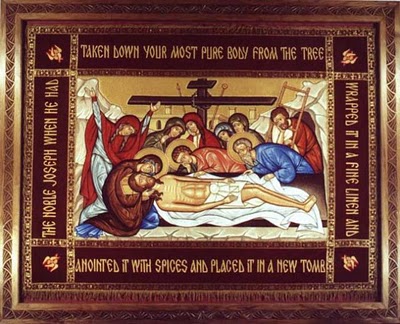Many Protestants know of Isaiah 53 which predicted Christ’s suffering, but few know of the Wisdom of Solomon which predicted the persecution of Christ by ungodly men.
One unexpected blessing of becoming Orthodox has been a larger Old Testament. Where many Protestant bibles omit the Deuterocanonical books (often referred to as “Apocrypha”), Orthodox bibles include them. The reason for the inclusion is because the Old Testament used by the Apostles was the Septuagint which included the Wisdom of Solomon. The Septuagint is a Greek translation of the Jewish bible that also included books written from the fourth century to the first century before Christ.
It may surprise some readers that the King James Version originally contained the “Aprocrypha,” and even has the Wisdom of Solomon. Reformed Christians may be surprised that the Geneva Bible likewise contained a section, “the Apocrypha.” Originally, Protestants accepted the “Apocrypha.” This reflected their respect for historic listing of biblical books. It would not be until the 1700s and 1800s that there would take place the large scale exclusion of the Deuterocanonical books leading to the Protestants’ loss.
Christ the Son of God
The second chapter of Wisdom of Solomon describes the sufferings of no ordinary man, but that of the Christ, the Son of God. Augustine of Hippo in City of God Book 2 Chapter 20 (NPNF vol. 2 p. 357) saw this passage as a prophecy of Christ’s Passion. These verses describe the inner thoughts or dialogue among the ungodly about the righteous man. Their indifference to God becomes manifest in their hatred to God’s Son.
He professes to have knowledge of God,
And calls himself a child of the Lord.
He became to us a reproof of our thoughts;
The very sight of him is a burden to us,
Because his manner of life is unlike that of others,
And his ways are strange.
We are considered by him as something base,
And he avoids our ways as unclean;
He calls the last end of the righteous happy,
And boasts that God is his father.
(Wisdom of Solomon 2:13-16; RSV)
The Christ to Suffer
Where Isaiah 53 focuses on Christ’s sufferings, Wisdom of Solomon 2 highlights the inner thoughts of Christ’s enemies.
Let us see if his words are true,
And let us put these last things to the test
at the end of his life.
For if the righteous man is a son of God, He will help him.
And deliver him from the hand of those who oppose him.
(Wisdom of Solomon 2:17-18)
Let us test him with insult and torture
That we may know his gentleness
And test his patient endurance.
Let us condemn him to a shameful death,
For there shall be a visitation because of him.
(Wisdom of Solomon 2:19-20; RSV)
On Holy Thursday evening, the Orthodox Church remembers the horrific events of Christ’s last hours in the service known as the “Twelve Gospels.” During this service passages from all four Gospels are read commemorating Christ’s saving death. Knowing Old Testament passages like Isaiah 53 and Wisdom of Solomon 2 can help us better understand Christ’s suffering.
Scripture Fulfilled
It is possible that Jesus had Isaiah 53 and Wisdom of Solomon 2 in mind when he informed his disciples of his imminent death. We read in Mark’s Gospel:
And He began to teach them that the Son of Man must suffer many things, and be rejected by the elders and chief priests and scribes, and be killed, and after three days rise again. (Mark 8:31-32)
Later we read in Mark 15:29-31 of the chief priests and scribes making fun of Christ:
And those who passed by blasphemed Him, wagging their heads and saying, “Aha! You who destroy the temple and build it in three days, save Yourself, and come down from the cross!”
Likewise the chief priests also, mocking among themselves with the scribes, said, “He saved others; Himself He cannot save. Let the Christ, the King of Israel, descend now from the cross, that we may see and believe.” (Mark 15:29-32; OSB)
The Good News
Behind the horrific indignities and torture inflicted on Jesus Christ is the mystery of God’s powerful and redemptive love. Apostle Paul explained in Romans:
But God demonstrates his love toward us, in that while we were still sinners, Christ died for us. Much more then, having now been justified by His blood, we shall be saved from wrath through Him. For if when we were enemies we were reconciled to God through the death of His Son, much more, having been reconciled, we shall be saved by His life. (Romans 5:8-10; OSB)
The phrase “by His life” points to Christ’s resurrection. Christ’s death on the Cross is followed by his resurrection. The two together comprise the Good News. Between Good Friday and Easter Sunday is Holy Saturday — a time of waiting. As we wait, let us meditate on God’s tender mercies for us sinners.



thanks Robert…excellent post
“The reason for the inclusion is because the Old Testament used by the Apostles was the Septuagint which included the Wisdom of Solomon. The Septuagint is a Greek translation of the Jewish bible that also included books written from the fourth century to the first century before Christ.”
This is common, even going back to at least maybe Augustine, but the logic is incredibly faulty.
The Septuagint was not translated all at once like some in ancient times erroneous believed. Its not one unit. There are a number of books that got translated into Greek, because Greek was the main language of the time. That’s not the same thing as there being one huge unit with a complete canon called “the Septuagint”.
This can be seen to be faulty in at least two ways.
First, Melito of Sardis. Melito asked the Palestinian (Jewish) church to help clarify what books were in the Old Testament canon. Why would he do this if all he had to do was say “I’ll go look at the LXX”?
Second, we see from textual analysis that the New Testament writers use manuscript traditions other than the LXX (as well as the LXX). Ones that are closer to the Masoretic tradition.
In other words, this is rationale is false.
Dear Geoff,
Thank you for visiting the OrthodoxBridge. The main point of the article was inspirational. I wanted readers to appreciate the value of deuterocanonical books like the Wisdom of Solomon. As a former Protestant, I was not aware of the blessings of the deuterocanonical books and so in light of the upcoming Easter celebration I wanted to give my readers something biblical and inspiring to reflect on.
With respect to your comment, please be careful not to jump to conclusions. First of all, I did not say that the Septuagint was translated all at once. The New Bible Dictionary (1982) in the entry on the “Canon of the Old Testament” noted that the Bible in the early Church was not a book set between two covers but rather “a memorized list of scrolls.” In time the Old Testament canon became fixed which included the protocanonical and deuterocanonical books.
I’m puzzled by your reference to Melito of Sardis. I checked Eusebius’ Church History 4.26.13-14, and it has him giving the list of the Old Testament protocanonical books to one Onesimus. From the passage it is evident that Melito of Saris already knew the Old Testament. In any event, Melitos’ acceptance of the protocanonical books does not entail a rejection of the deuterocanonical books. Melito’s “incomplete” listing is not surprising as the early Church did not view the deuterocanonical books being on the same level as the protocanonical books.
As far as the New Testament writers citing the Septuagint that’s the general view of bible scholars. You seem to imply that the Apostles were citing a source other than the Septuagint but that’s contrary to biblical scholarship. Swete’s Introduction to the Old Testament in Greek notes: “There is considerable weight of evidence in favour of the belief that the Evangelists employed a recension of the LXX. which came nearer to the text of cod. A than to that of our eldest uncial B.” (p. 395) I invite you to cite a bible scholar who supports your position. Please keep in mind that I’m speaking generally; the Apostles sometimes paraphrased the Septuagint or they drew on a text similar to the Septuagint. And with respect to your claim that textual analysis shows that the New Testament writers used a non-Septuagint source, I checked my Nestle-Aland XXVII and drew a blank. Again, I invite you to provide supporting evidence in support of your comments. You seem to favor the Masoretic text but keep in mind that the Masoretic text dates back to the seventh to the eleventh centuries. The Septuagint and the Dead Sea Scrolls are considerably older than the Masoretic Text that you seem to prefer. I recommend you read Gabe Martini’s excelent article: “The Masoretic Hebrew vs. The Septuagint (Part II).”
Robert
Robert and Geoff,
It is hard not to weigh in on this one, having read a lot about the history of the canon. The NT authors, contrary to what is often said off-the-cuff by many scholars (!), did not use the LXX the majority of the time. They used a variety of textual traditions as can be confirmed using hard numbers in books such as “The Use of the Septuagint in New Testament Research” by McLay and “Biblical Exegesis in the Apostolic Period” by Richard Longenecker. The text of the NT quotes often agree with the LXX, the MT (Masoretic Text), or reflect other non-aligned texts. Longenecker demonstrates (see also Emanuel Tov in his “Textual Criticism of the Hebrew Bible” [2nd ed.]) that the texts of the OT were pluriform, and that, though the proto-MT seems to have been sanctioned by the keepers of the temple, the NT writers felt free to use not only whatever texts were at hand, but to choose texts that best fit their argument! An example of this latter phenomenon can be found in Hebrews if I’m not mistaken. As for the Masoretic Text itself, though it bespeaks a medieval group of manuscripts, the proto-Masoretic manuscripts at Qumran make up about 35% of the textual strain of the DSS (Dead Sea Scrolls), while a strain agreeing with the LXX comes in quite a bit lower if I am not mistaken. Again, that shows that, whatever the Qumran community felt about the status of the different textual traditions, their library proves that the 2nd Temple Period Jews had access to a pluriform (rather than standardized) text.
Thank you for your input. Much appreciated!
Prometheus,
There are several major issues with the statistics Tov provides and his methodology for arriving at them. I recommend looking deeply into them and determining if such arbitrary categorization is justified, when Tov himself acknowledges his departure from accepted methodologies, justifying them by reference to his trust in the later MT? The methods he uses to create his list are created by him and are weighted towards his own desired conclusion, as can be seen in his departure from his own previous methods of categorization and the weighted methods he employs. This can be verified by his own footnotes, or in brief by reading The Meaning of the Dead Sea Scrolls: Their Significance For Understanding …
By James VanderKam, Peter Flint Pg 142-143. Giving preference to, and Grouping texts in the MT category that are equally in accordance with multiple text types, while at the same time categorizing as “non-aligned” texts which equally testify to the LXX and other texts types is not a methodology that is accepted, nor is it one that is going to give a true picture. It is literally skewing the numbers. This is only the tip of the iceberg in respect to the analysis provided by the statistics you are quoting. There are several key factors not included in analysis at the outset that are excluded on some pretext. As a student of these methodologies, I can tell you that I don’t have an issue with the historical reality of various textual tradition (aka Pluriform) However, the numbers you are quoting are a product of an arbitrarily arranged analytical process whose very assumptions are based on an admitted departure from accepted norms in favor Of a new categorical method of Tov’s own desire.